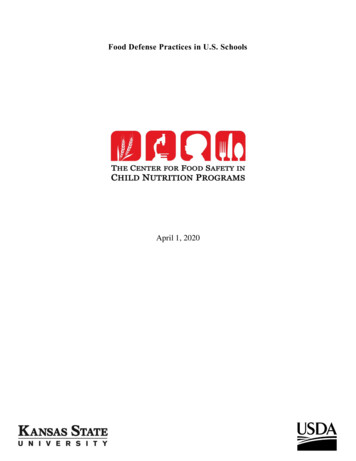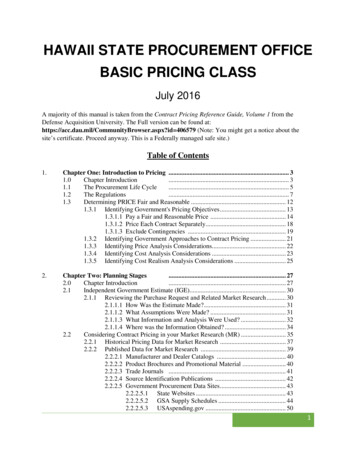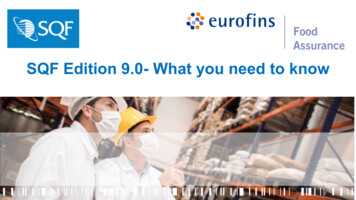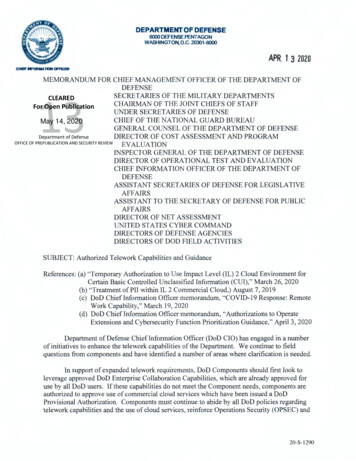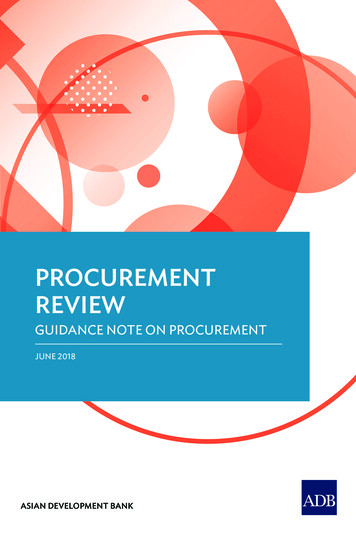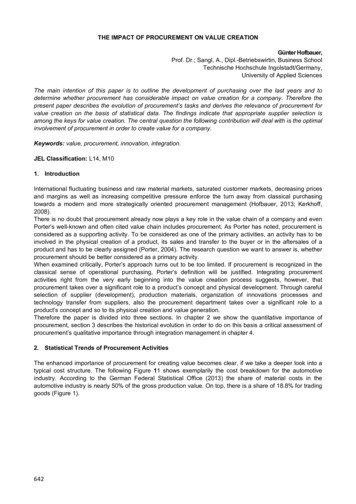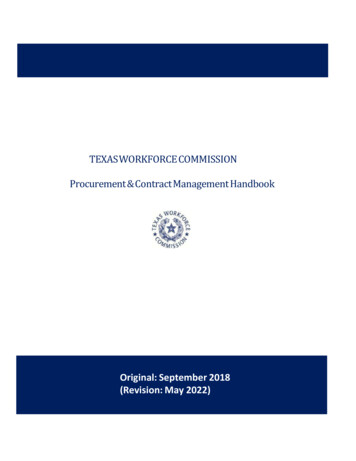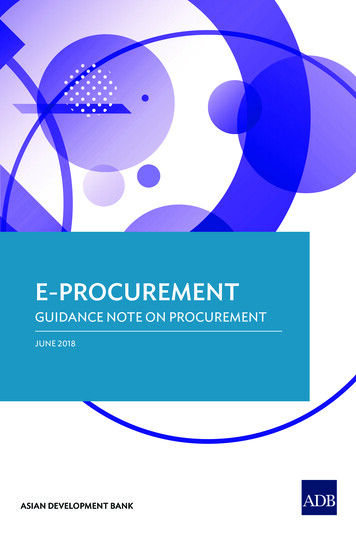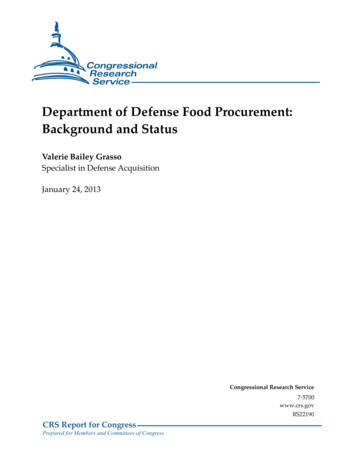
Transcription
Department of Defense Food Procurement:Background and StatusValerie Bailey GrassoSpecialist in Defense AcquisitionJanuary 24, 2013Congressional Research Service7-5700www.crs.govRS22190CRS Report for CongressPrepared for Members and Committees of Congress
Department of Defense Food Procurement: Background and StatusSummaryMilitary food items, also known as subsistence items, are generally procured under the auspicesof the Defense Logistics Agency (DLA), an agency of the Department of Defense (DOD) whichprovides worldwide logistics support for the U.S. military services. Under DLA, DLA TroopServices (formerly the Defense Supply Center Philadelphia) is the inventory control point forfood, clothing, textiles, medicines, medical equipment, general and industrial supplies, andservices for the military, their eligible dependents, and other non-DOD customers worldwide.DLA Troop Services buys and manages about 13.4 billion worth of food, clothing, textiles, andother products. Under DLA Troop Services, the Subsistence Directorate serves as the operationalmanager for all food operations. These items are procured in accordance with the provisions ofthe Berry Amendment and the Buy American Act (BAA). The Berry Amendment requires DODto give preference to the procurement of domestically produced, manufactured, or home grownproducts, notably food, clothing, and fabrics. This report will describe the origin, authority, andpolicy in the procurement of food for the military.Congressional Research Service
Department of Defense Food Procurement: Background and StatusContentsBackground . 1Defense Logistics Agency . 2Procurement Authority and Policy . 2Current Status of the Military Food Acquisition Process . 3The DLA Troop Services Subsistence Directorate . 4ContactsAuthor Contact Information. 5Congressional Research Service
Department of Defense Food Procurement: Background and StatusBackgroundPrior to World War II, each United States (U.S.) military service organization procured anddistributed its own food. Right after World War II, Congress mandated that a commission(ultimately called the Hoover Commission) study the logistical management of military food andsupplies, and recommended a more centralized management of perishable foods, preferably inone organization. This effort resulted in the establishment of a joint Army-Navy-Air ForceSupport Center; for the first time, all military services bought, stored, and issued military itemsusing a common system. In addition to food items, DOD and the military services defined othermateriel that would be managed by this system as “consumables,” or “commodities,” meaningsupplies that are not repairable or are consumed in normal use.In the mid-1950s, the structure for the procurement of food and consumable items changed. Eachmilitary service acted as a single manager for various categories of consumables issued by allfour services; each single manager would buy items, store and issue supplies, manage inventories,and forecast future requirements. For example, the U.S. Army bought and managed all militaryfood and clothing; the Navy managed all medical supplies, petroleum, and industrial parts; andthe Air Force managed all electronic items. The single manager system reduced costs bycentralizing wholesale stocks, simplifying the supply chain, and persuading each military serviceto adopt the same standard items. However, the single manager concept was only partiallysuccessful because it did not provide uniform procedures among the services.In 1961, then Secretary of Defense Robert McNamara ordered that the single-manager agenciesbe consolidated into one agency, resulting in the establishment of the Defense Supply Agency,1the forerunner to the Defense Logistics Agency (DLA). In 1986, the Goldwater-Nichols Actidentified DLA as a combat support agency.21The Defense Supply Agency (DSA), the forerunner to the Defense Logistics Agency, was established on October 1,1961, and began operations on January 1, 1962. Eight single manager agencies became DSA supply centers. In 1965,DOD consolidated most of the contract administration activities of the military services to avoid duplication of effortand provide uniform procedures in administering contracts. Officials established the Defense Contract AdministrationService (DCAS) within DSA to manage the consolidated functions. The agency’s new contract administration missiongave it responsibility for the performance of most defense contractors. The agency’s responsibilities extended overseaswhen it assumed responsibility for defense overseas property disposal operations and worldwide procurement,management, and distribution of coal and bulk petroleum products (1972), and worldwide management of food itemsfor troop feeding and in support of commissaries (1973). In recognition of 16 years of growth and expandedresponsibilities, on January 1, 1977, officials changed the name of the Defense Supply Agency to the Defense LogisticsAgency (DLA). See the History of the Defense Logistics Agency, at http://www.dla.mil/history/storyboard.htm.2DLA is a global logistics combat support operation which oversees three supply centers to meet the needs of militaryand civilian customers: DLA Aviation in Richmond, Virginia, which is the lead center for aviation weapon systems andthe primary source for approximately 930,000 repair parts and operating systems; DLA Land and Maritime inColumbus, Ohio, which supplies weapon system and electronic spare parts; and DLA Troop Support in Philadelphia,Pennsylvania, the troop support center supplying subsistence items including food, clothing, medical, and industrialsupport. According to DLA’s website, DLA employs 27,000 civilian and military employees worldwide working in 48states and 28 foreign countries. http://www.dla.mil/ataglance.aspx.Congressional Research Service1
Department of Defense Food Procurement: Background and StatusDefense Logistics AgencyDLA is an agency under the Department of Defense, Office of the Under Secretary of Defense forAcquisition, Technology and Logistics. DLA is DOD’s largest logistics, combat support agency.Today DLA provides worldwide logistics support in both peacetime and wartime to the militaryservices, civilian agencies, and foreign countries. DLA supplies almost every consumable itemAmerica's military services need to operate, from groceries to jet fuel. DLA supported everymajor war and contingency operation of the past four decades, from the Vietnam War toOperation Iraqi Freedom. The subsistence acquisition mission is carried out by DLA TroopSupport, formerly Defense Supply Center, Philadelphia (DSCP); a field activity within DLA.3According to DLA, the DLA Director has been designated by the Deputy Secretary of Defense asthe Executive Agent (EA) for Subsistence, Bulk Fuels, Construction and Barrier Materials, andMedical Materiel.4 As described on DLA’s website:As DLA Executive Agent, the Director of DLA is the focal point for providing continuous,sustainable and global end-to-end supply chain support as required by end users. The DODEA ensures effective support throughout operations by developing coordinated processes andsupport plans for transition from peacetime to wartime and/or contingency operations.5Under DLA, DLA Troop Support is responsible for nearly all of the food, clothing, and medicalsupplies used by the military. DLA Troop Support is comprised of the following business areas:(1) Clothing & Textiles; (2) Construction & Equipment; (3) Weapon Systems Detachments; (4)Medical; (5) Subsistence; and (6) Customer Operations. Under Subsistence, DLA Troop Supporthas developed a new approach to industrial base preparedness, through the development of an“Industrial Base Preparedness Toolbox.”6 DLA Troop Support operates as a Defense WorkingCapital Fund activity; all operating costs must be charged back to the individual customer on abreak-even basis.7Procurement Authority and PolicyMilitary food items are procured in accordance with the provisions of the Berry Amendment andthe Buy American Act (BAA).8 The Berry Amendment [Title 10, United States Code (U.S.C.),Section 2533a] requires DOD to give preference to the procurement of domestically produced,manufactured, or home grown products, notably food, clothing, and fabrics.9 The Berry3In 2010, DSCP Philadelphia was renamed DLA Troop Support. http://www.dscp.dla.mil/history.asp.Department of Defense Directive 5101.1, DOD Executive Agent, September 3, 2002 (Updated May 1, ttp://www.dscp.dla.mil/subs/rations/ibp/ibpbrief files/frame.htm7Title 10, United States Code (U.S.C.) § 2208.8The Buy American Act (41 U.S.C. 10a through 10d, as amended) is the principal domestic preference statutegoverning most procurement by the federal government. It restricts foreign access to U.S. government procurement bygiving preference to domestically produced, manufactured, or home grown products. For further discussion of the BuyAmerican Act, refer CRS Report 97-765, The Buy American Act: Requiring Government Procurements to Come fromDomestic Sources, by John R. Luckey.9The Berry Amendment can found be found in 10 U.S.C. 2533a For further discussion of the Berry Amendment, referto CRS Report RL31236, The Berry Amendment: Requiring Defense Procurement to Come from Domestic Sources, byValerie Ann Bailey Grasso.4Congressional Research Service2
Department of Defense Food Procurement: Background and StatusAmendment is referenced in the Defense Federal Acquisition Regulation Supplement (DFARS),Part 225.7002, as described below.Unless a specific exception in law applies, the products, components, or materials listedbelow must be grown, reprocessed, reused, or produced in the United States if they arepurchased with funds made available (not necessarily appropriated) to DOD. Except formanufactured or processed food, and chemical warfare protection clothing as explained inDFARS 225.7002-2 “Exceptions,” this applies to prime contractors and subcontractors atany tier.10Current Status of the Military Food AcquisitionProcessThe various stages of the military food acquisition process are described below: From the customer’s perspective, the acquisition process begins with thegeneration of a product need or requirement. The customer receives anintroductory presentation about the Prime Vendor Program11 and identifies theirorganization’s ongoing, new, or anticipated requirements.12 DLA Troop Servicesgathers the data and develops a formal solicitation package to meet therequirement. At the same time, a DLA Troop Services specialist prepares a formal solicitationwhich incorporates federal laws, regulations, and guidelines for the acquisition ofsubsistence items. The solicitation is prepared based on what represents the bestvalue to the federal government, and is amended and modified as moreinformation is received. A broad range of potential vendors are invited toparticipate in an industry forum to learn more about requirements and resolve orclarify questions about the solicitation. The solicitation is announced and remains open for bids for approximately 50days; meanwhile a pre-proposal conference is also held. Prospective vendors maycontact the DLA Troop Services specialist to raise questions, offer suggestions,and to discuss and review all elements of the solicitation; further charges to thesolicitation may occur, based on the feedback received from potential vendors.Based on the pre-proposal conference findings, any additional amendments to thesolicitation must be issued to all prospective vendors on the mailing list. The evaluation phase begins; each technical proposal is received fromprospective vendors and individually evaluated to identify its strengths andweaknesses. The evaluation is conducted by a team of subject matter experts.Each technical proposal must demonstrate that the prospective vendor can meet10Restrictions on DOD Purchases from Non-U.S. Sources Imposed by 10 U.S.C. 2533a.The Subsistence Prime Vendor Program is an electronic order and receipt system used for managing the fooddistribution system.12DLA Troop Support customers include, but are not limited to, the following groups: the military services, DefenseCommissary Agency, Military Exchanges and Morale, Welfare and Recreation Facilities, Job Corps Centers, VeteransAdministration Hospitals, Federal prisons, as well as schools and Indian reservations.11Congressional Research Service3
Department of Defense Food Procurement: Background and Statusthe requirements as set forth in the solicitation, in accordance with “Best Value”selection criteria.13 At the conclusion of the evaluation phase, the contract award decision is madeand a contract award decision is announced. The contract becomes effectiveusually between 30 to 60 days after the award announcement. The DOD regionalmanager arranges a post-award conference at the selected vendor’s facility,typically within two weeks after the announcement. During the post-awardconference, which is jointly conducted by the DLA Troop Services specialist andthe vendor, all issues involving the structure and execution of the contract arediscussed. At the conclusion of the post-award conference, the installation, vendor, andDLA Troop Services specialist will develop a catalogue of the vendor’s productline. This step ensures that all of the items required by the customer are properlycoded and contained in the catalogue.The DLA Troop Services Subsistence DirectorateThe Subsistence Directorate is divided into the following business units: Food Services,Operational Rations, Produce, Food Safety Office, and Supplier Support. A description of thework of each business unit follows.Under Food Services, the Subsistence Prime Vendor Program (SPV) has replaced the formerdepot stock distribution system with an electronic order and receipt system. Through the use ofelectronic data interchange (EDI) orders are transmitted and received at the vendor’s plants withinminutes, allowing for reduced local inventory levels. EDI enhances the accuracy and timelinessof orders as well as the quality of the products; as a result, both the inventory and associatedoverhead costs are reduced, and the goal for the maximum turnaround time (from order todelivery) is 48 hours. According to DLA, there are about 50 prime vendors who manage andsupply food in regions around the world.The Operational Rations Unit provides the managerial and logistical support for supplying mealsfor the military, including individual rations, group rations, survival rations, ultra hightemperature milk, emergency and sterile drinking water, humanitarian daily rations, and fieldfeeding equipment. While the “Meal, Ready-to-Eat (MRE)” is the core individual combat rationfor the military, the military services also consider the special dietary needs of the soldiers(including vegetarian and kosher needs).1413Each subject matter expert independently reviews the technical proposal and, in accordance with solicitationguidelines “best value” selection criteria. Such criteria may include the following factors: the distribution and deliverysystem, location, record of past performance, corporate experience, electronic data interchange capability,socioeconomic considerations, and others; the subject matter experts may make site visits to the prospective vendorswarehouse or operations site. The evaluation phase may take longer than 50 days. See Federal Acquisition Regulation Part 15, Contracting by Negotiation, for a discussion of the term “best value” as a type of contract acquisition a/fact/food/mre.htm. One MRE provides an average of 1,250 caloriescomposed of 13% protein, 36% fat, and 51% carbohydrates. DLA Troop Support does not sell rations to individuals;DOD regulations and policy permit the sale of rations to certain U.S. military and federal government organizations.The prices for the various Operational Rations can be found at ngressional Research Service4
Department of Defense Food Procurement: Background and StatusThe Produce Unit provides fresh fruits and vegetables to the military services, the DefenseCommissary Agency, Military Exchanges, Morale, Welfare and Recreation facilities, Job CorpsCenters, Veterans Administration hospitals, federal prisons, as well as DOD schools and Indianreservations. Under the Produce Unit, the DOD Fresh Program is a partnership between the U.S.Department of Agriculture’s Food and Nutrition Service, and the Produce Division, whereby DLATroop Services buys and distributes fresh fruits and vegetables to schools using the USDA’sfederal commodity entitlement dollars. The Farm Security and Rural Investment Act of 2002contained statutory language that sets aside 50 million annually for DLA Troop Services tocontinue to support school lunches. The Produce Unit distributes over 300 different produce itemsto schools.15The Food Safety Office is responsible for food safety and quality assurance policies for theservices, DOD agencies, and components, in partnership with the U.S. Army’s ResearchDevelopment and Engineering Command, a division of the U.S. Army Soldier Systems Center;the U.S. Army Veterinary Command, the Food and Drug Administration, and the USDA.16The Supplier Support Division supports the supplier operations within the subsistence supplychain by providing a wide variety of administrative and logistical support.17Author Contact InformationValerie Bailey GrassoSpecialist in Defense Acquisitionvgrasso@crs.loc.gov, 7-761715For background and funding on the National School Lunch Program, see http://www.dscp.dla.mil/subs/produce/index.htm and CRS Report R40397, Child Nutrition and WIC Programs: A Brief Overview, by Joe Richardson. TheChild Nutrition Reauthorization Act was signed into law (P.L. 111-296, Dec. 13, pport/index.asp.Congressional Research Service5
According to DLA, the DLA Director has been designated by the Deputy Secretary of Defense as the Executive Agent (EA) for Subsistence, Bulk Fuels, Construction and Barrier Materials, and Medical Materiel.4 As described on DLA's website: As DLA Executive Agent, the Director of DLA is the focal point for providing continuous,
